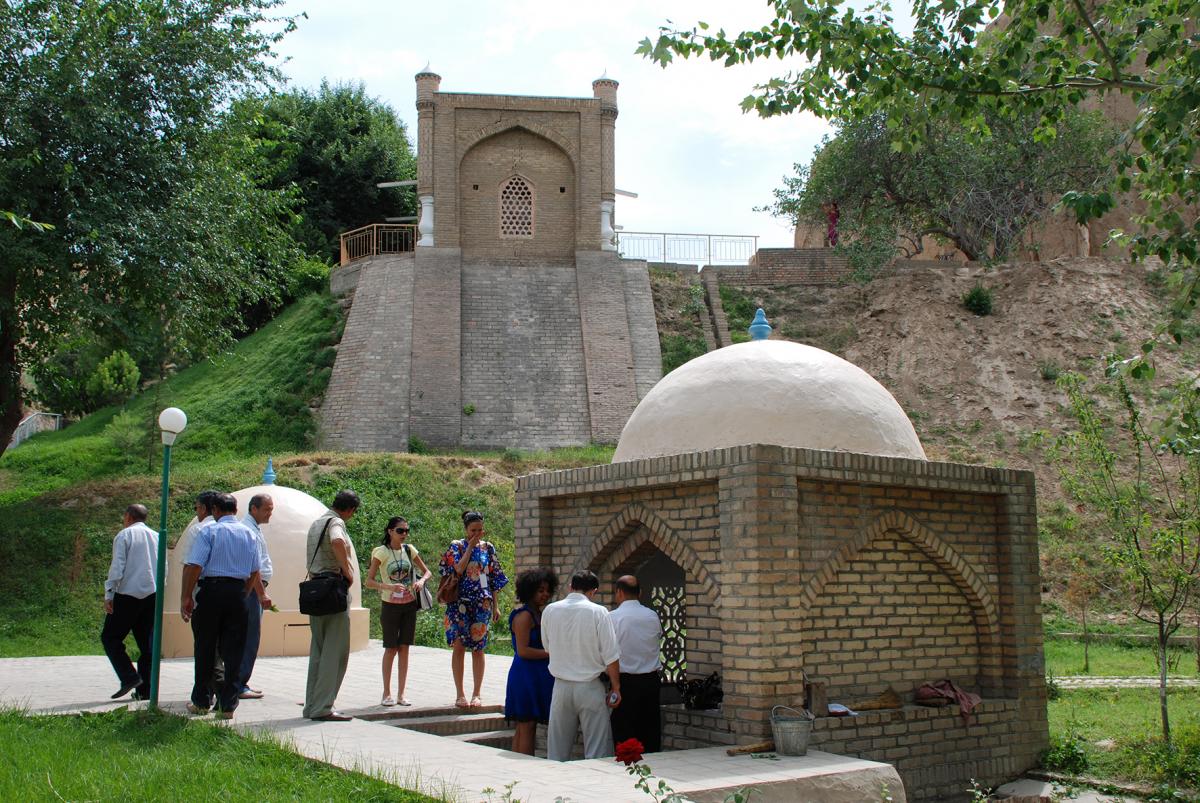Shrines of Uzbekistan
Hojja Daniyar Shrine

One of the most ancient, worldwide known legends is that of the Old Testament prophet Daniel. He is equally revered by the followers of three religions– Jews, Christians and Moslems. According to the Bible, Daniel, who was called Hojja Daniyar by Moslems, was a descendant of King Solomon and lived in the 5th-4th centuries B.C. in Jerusalem. God endowed him with ability to prophesy.
Daniel properly interpreted one of the Nebuchadnezzar’s dreams, and was lavishly showered with the king’s favours. Having moved to Babylon, Daniel foretold many impending events including the destruction of the Persian Kingdom by the Greeks and the breakup of the empire of Alexander the Great into four parts. Daniel accurately predicted, four hundred years before the events occurred, the advent of Christ in Jerusalem, the Crucifixion and the Resurrection. One of the visions was that of God imparting to the mankind the holy book “closed up and sealed until the time of the end”, which is the Koran.
Once Daniel had a vision of “a man clothed in linen”, who ordered him to make a journey to distant countries. Thus one day he arrived in Samarkand, to the court of the Persian Achaemenid satrap of Sogd. He lived in Samarkand through the last years of life, having reached a very old age. The Christians praise Prophet Daniel’s memory, and the Moslems alike revere Hajji Daniyar as saint.
At Afrosiab archeological site, which hides the ruins of ancient Marakanda, at the edge of a cliff overhanging the Siab river, there is one of the oldest Samarkand burial places - Hajji Daniyar mazar. The Prophet’s mortal remains are buried here.
Unusually long sarcophagus, 20 metres in length, can be explained by a mysterious quality of the saint’s body to grow. It goes on growing in the grave and has already become gigantic. (Some explorers believe that the tombstone of such a size was meant to protect the prophet’s remains from desecration: it is not easy to find the remains in such a big grave)
Next to Hajji Daniyar’s tomb there is a spring. Its water is believed to be holy, able to heal both body and soul. All year round pilgrims belonging to various religions come to the shrine for cure from all over the world.
Imam al-Bukhari memorial complex
For centuries a center of Islamic theological activities was Bukhara, one of the oldest Central Asian towns. It won the honorary titles of “the Dome of the Faith” and “the Blessed Town”, and became sacred town to all the Moslems
To a great extent Bukhara managed to get such a status thanks to the eminent Sunni scholar Imam Abu Abdullah Muhammad ibn Ismail al-Bukhari. He went down in history as the author of Al Jami as Sahih, a collection of the most authentic hadiths, the book second only to the Koran. From the extant records we know that al-Bukhari was born in Bukhara in 810. His grandfather was a fire-worshipper who accepted Islam. His father, Ismail ibn Ibrahim, was considered quite an educated man; he kept in memory a lot of dastans and legends, and was known as a muhaddith, a person who profoundly knew and narrated hadiths - oral traditions of the Prophet’s words and deeds. It is no wonder that in his childhood al-Bukhari, who had an inquiring mind and a lot of diligence, began to excel at theological subjects. But what he was particularly interested in was the study of hadiths.
Driven by his thirst for knowledge, young Al-Bukhari turned from one teacher to another and moved from Damascus to Cairo, from Basra to Baghdad, from Hijaz to Kufah. Wherever he traveled he collected and put down hadiths. From almost 800 000 traditions he managed to collect, he finally selected 7397, those he believed to be authentic. In his book Al Jami as Sahih he arranged them according to the subject. The book contains chapters on history, law, ethics, medicine and other subjects. Many of the hadiths of the book were later included in Sharia – Moslem principles of jurisprudence, thus getting the status of a law for the faithful.
Another fundamental work by al-Bukhari dealt with the biographies of almost a thousand narrators of hadiths. The scholar had been working on the book for almost 16 years and accordingly entitled it At-Tarikh al-Kabir, which means “The Great History”. Altogether Imam al-Bukhari wrote about 20 works on theology, which dealt with a wide range of philosophical issues.
Al-Bukhari spent most of his life traveling from one country to another, collecting hadiths and enlightening the faithful. At the end of his life he returned home, to Bukhara. Emir Halid ibn-Ahmad summoned al-Bukhari to live in the palace and participate in the talks of the court scholars. But al-Bukhari did not want to change his mode of life. Emir ordered to banish al- Bukhari from Bukhara.
Old al-Bukhari had to settle down in the village of Khartang located in 12 kilometres from Samarkand, where he died in the year of 870 at the age of 60. His grave became sacred. In the 16th century there was built a burial-vault and a mosque over his grave, with plane trees planted around. In the course of time these constructions dilapidated, and in 1998 there was built a memorial complex at the site. The complex consists of a mausoleum and a mosque which can accommodate up to 1500 believers at a time. A visit to al-Bukhari memorial is considered by the Moslems to be equal to a minor hajj.
 ENG
ENG  РУС
РУС
 O'Z
O'Z